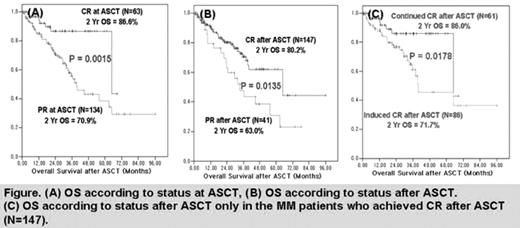Abstract
Upfront high dose myeloablative chemotherapy followed by single ASCT is a standard therapy for the newly diagnosed MM patients under 65 years. Disease status after the induction chemotherapy is variable, so we evaluated the prognostic effect of the disease status at ASCT especially in the initial chemo-sensitive MM patients. We retrospectively analyzed the initial chemo-sensitive MM patients (≥ PR) enrolled from KMMWP web based registration (www.myeloma.or.kr). Between Nov 1996 and Jan 2007, 197 MM patients (median age 53) were treated with induction chemotherapy followed by single ASCT at 8 institutions in Korea. All the patients received PBSCs support after conditioning with melphalan alone. Some patients with no detectable M-protein without testing immunofixation or positive immunofixation result were classified as CR. Median follow-up time was 21.2 months (0.4–96.0) from the day of ASCT. CR and PR at ASCT were achieved in 63 (32%) and 134 (68%), respectively. The initial DS stage was not correlated with disease status at ASCT, but initial low stage according to the ISS & SWOG staging system were correlated with CR status at ASCT (P=0.017, P=0.044, respectively). Overall survival from the day of ASCT (OS) was significantly correlated with CR status at ASCT comparing with PR status at ASCT (P=0.0015). OS according to the status at ASCT among the patients who received VAD induction chemotherapy (N=161) showed same results (P=0.002). CR status after ASCT also predict OS (P=0.0135), but the MM patients with continued CR after ASCT showed significantly higher OS after ASCT compared with induced CR patients after ASCT who had PR status before ASCT (P=0.0178). Multivariate analysis indicated that status at ASCT (CR versus PR) was a significant prognostic factor for prediction of OS after ASCT (P=0.012 by Cox proportional hazard analysis, OR=2.83, 95% CI, 1.25–6.37). We concluded that MM patients with CR at ASCT had better OS comparing with PR at ASCT. And continued CR status after ASCT may be a very important prognostic factor. So we should try more intensive induction chemotherapy regimens including new anti-myeloma agents to achieve maximum response status just before ASCT.
Figure. (A) OS according to status at ASCT, (B) OS according to status after ASCT. (C) OS according to status after ASCT only in the MM patients who achieved CR after ASCT (N = 147).
Figure. (A) OS according to status at ASCT, (B) OS according to status after ASCT. (C) OS according to status after ASCT only in the MM patients who achieved CR after ASCT (N = 147).
Author notes
Disclosure: No relevant conflicts of interest to declare.


This feature is available to Subscribers Only
Sign In or Create an Account Close Modal